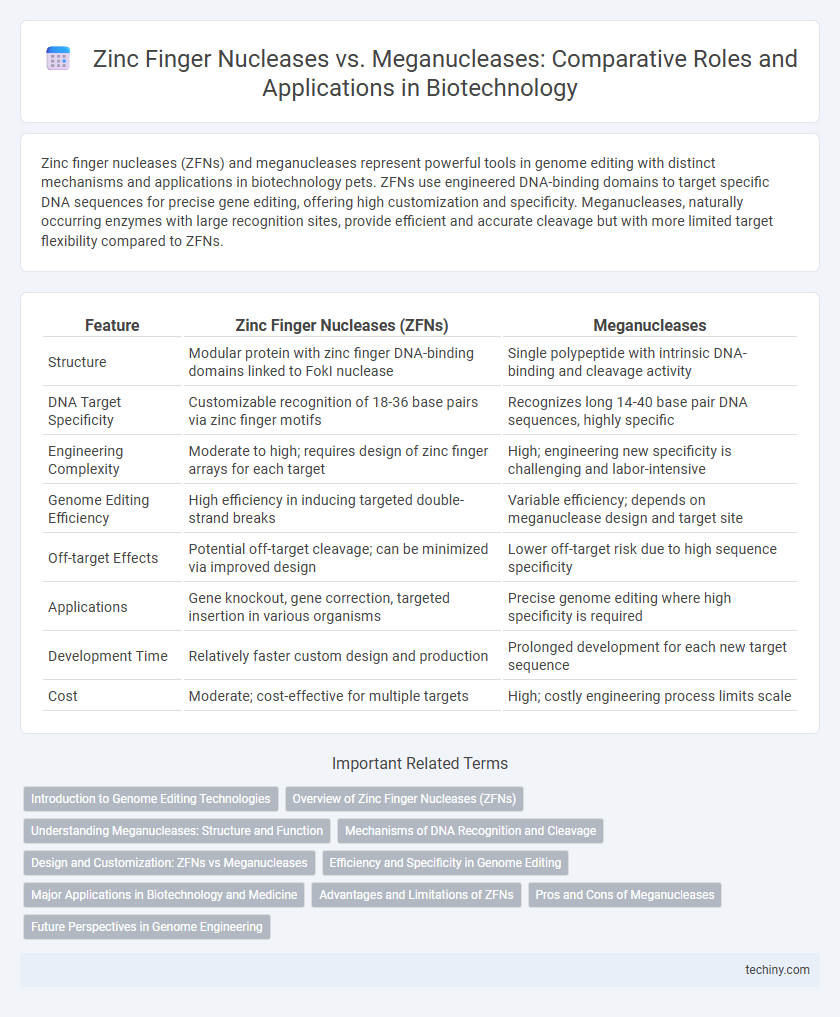Zinc finger nucleases (ZFNs) and meganucleases represent powerful tools in genome editing with distinct mechanisms and applications in biotechnology pets. ZFNs use engineered DNA-binding domains to target specific DNA sequences for precise gene editing, offering high customization and specificity. Meganucleases, naturally occurring enzymes with large recognition sites, provide efficient and accurate cleavage but with more limited target flexibility compared to ZFNs.
Table of Comparison
| Feature | Zinc Finger Nucleases (ZFNs) | Meganucleases |
|---|---|---|
| Structure | Modular protein with zinc finger DNA-binding domains linked to FokI nuclease | Single polypeptide with intrinsic DNA-binding and cleavage activity |
| DNA Target Specificity | Customizable recognition of 18-36 base pairs via zinc finger motifs | Recognizes long 14-40 base pair DNA sequences, highly specific |
| Engineering Complexity | Moderate to high; requires design of zinc finger arrays for each target | High; engineering new specificity is challenging and labor-intensive |
| Genome Editing Efficiency | High efficiency in inducing targeted double-strand breaks | Variable efficiency; depends on meganuclease design and target site |
| Off-target Effects | Potential off-target cleavage; can be minimized via improved design | Lower off-target risk due to high sequence specificity |
| Applications | Gene knockout, gene correction, targeted insertion in various organisms | Precise genome editing where high specificity is required |
| Development Time | Relatively faster custom design and production | Prolonged development for each new target sequence |
| Cost | Moderate; cost-effective for multiple targets | High; costly engineering process limits scale |
Introduction to Genome Editing Technologies
Zinc finger nucleases (ZFNs) and meganucleases represent pivotal tools in genome editing technologies, each offering unique DNA-targeting mechanisms. ZFNs utilize engineered zinc finger protein domains to recognize specific DNA sequences combined with the FokI nuclease for DNA cleavage, enabling targeted gene disruption or correction. Meganucleases, naturally occurring homing endonucleases, recognize longer DNA sequences, providing higher specificity but limited target site flexibility compared to the modular design of ZFNs.
Overview of Zinc Finger Nucleases (ZFNs)
Zinc Finger Nucleases (ZFNs) are engineered DNA-binding proteins that enable targeted genome editing by creating double-strand breaks at specific genomic loci. Each ZFN consists of a zinc finger domain that recognizes specific DNA sequences and a FokI nuclease domain responsible for DNA cleavage. Compared to Meganucleases, ZFNs offer modular design flexibility, allowing precise targeting of diverse DNA sequences for applications in gene therapy, functional genomics, and crop improvement.
Understanding Meganucleases: Structure and Function
Meganucleases are highly specific DNA endonucleases characterized by their long recognition sequences, typically 14-40 base pairs, which enable precise genome editing with minimal off-target effects. Structurally, meganucleases consist of a DNA-binding domain fused to a catalytic domain that cleaves DNA through a coordinated metal ion-dependent mechanism. Unlike zinc finger nucleases, meganucleases offer a naturally evolved scaffold that facilitates efficient and accurate gene targeting in complex genomes.
Mechanisms of DNA Recognition and Cleavage
Zinc finger nucleases (ZFNs) recognize DNA through engineered zinc finger domains that bind specific triplet nucleotide sequences, enabling targeted DNA cleavage via the FokI nuclease domain. Meganucleases utilize highly conserved homing endonuclease domains that identify long, specific DNA sequences, facilitating precise double-strand breaks within complex genomic regions. Both systems exploit protein-DNA interactions to achieve targeted genome editing, but ZFNs offer modularity in design while meganucleases provide inherent sequence specificity.
Design and Customization: ZFNs vs Meganucleases
Zinc finger nucleases (ZFNs) offer modular design through engineered zinc finger domains that recognize specific DNA triplets, enabling customizable targeting of diverse genomic sequences. Meganucleases possess a naturally rigid DNA-binding domain with high sequence specificity, making their customization more complex and less flexible compared to ZFNs. The ease of engineering ZFNs for tailored genome editing contrasts with the limited, labor-intensive reprogramming requirements for meganuclease target recognition.
Efficiency and Specificity in Genome Editing
Zinc finger nucleases (ZFNs) exhibit higher modularity and customizable targeting efficiency compared to meganucleases, enabling precise genome editing at multiple loci. Meganucleases demonstrate exceptional specificity due to their longer recognition sequences, minimizing off-target effects but limiting target site availability. Trade-offs between ZFNs' efficiency in generating double-strand breaks and meganucleases' specificity dictate their application depending on genome editing requirements.
Major Applications in Biotechnology and Medicine
Zinc finger nucleases (ZFNs) are widely used for targeted genome editing in gene therapy, enabling precise correction of genetic disorders such as sickle cell anemia and HIV resistance. Meganucleases, with their longer DNA recognition sites, are primarily applied in functional genomics and crop improvement through stable and specific gene modifications. Both nucleases facilitate advancements in biotechnology by offering customizable tools for genetic engineering, yet ZFNs dominate clinical applications due to their modularity and efficiency in human cells.
Advantages and Limitations of ZFNs
Zinc finger nucleases (ZFNs) offer customizable DNA-binding domains enabling targeted genome editing with high specificity, making them advantageous for precise gene modifications. However, ZFNs face limitations such as off-target cleavage risks and complex engineering requirements for each new DNA target site. Their dependency on protein-DNA interaction design contrasts with meganucleases, which have inherently large recognition sites but less flexibility in target customization.
Pros and Cons of Meganucleases
Meganucleases offer high specificity for target DNA sequences, minimizing off-target effects due to their long recognition sites, making them ideal for precise genome editing. However, their engineering for new target sites is challenging and less flexible compared to zinc finger nucleases, limiting their adaptability in diverse applications. Despite this, meganucleases provide efficient and stable gene targeting, which is valuable in therapeutic gene correction and functional genomics.
Future Perspectives in Genome Engineering
Zinc finger nucleases (ZFNs) offer precise DNA targeting through customizable zinc finger domains, enabling versatile genome modifications. Meganucleases provide high specificity due to their long recognition sequences but face challenges in engineering flexibility. Future perspectives in genome engineering emphasize integrating the modularity of ZFNs with the specificity of meganucleases to develop novel nucleases with enhanced targeting accuracy and reduced off-target effects.
Zinc finger nucleases vs Meganucleases Infographic

 techiny.com
techiny.com